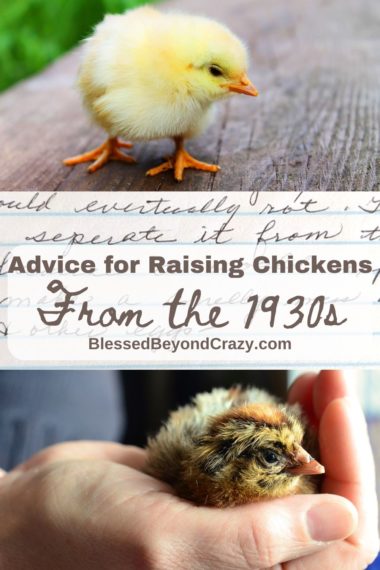
My husband and I decided to get chickens this spring. We keep thinking we wish my Grandmother, Maxine King, were still alive to see our chickens and advise us. She loved chicks and raised chickens most of her life. Recently, my mom found a journal from my Grandmother about raising chickens. I thought it would be nice to type it up, so we would always have her words and her great-grandchildren might someday read this. From this point forward, all the words are my Grandmother’s.
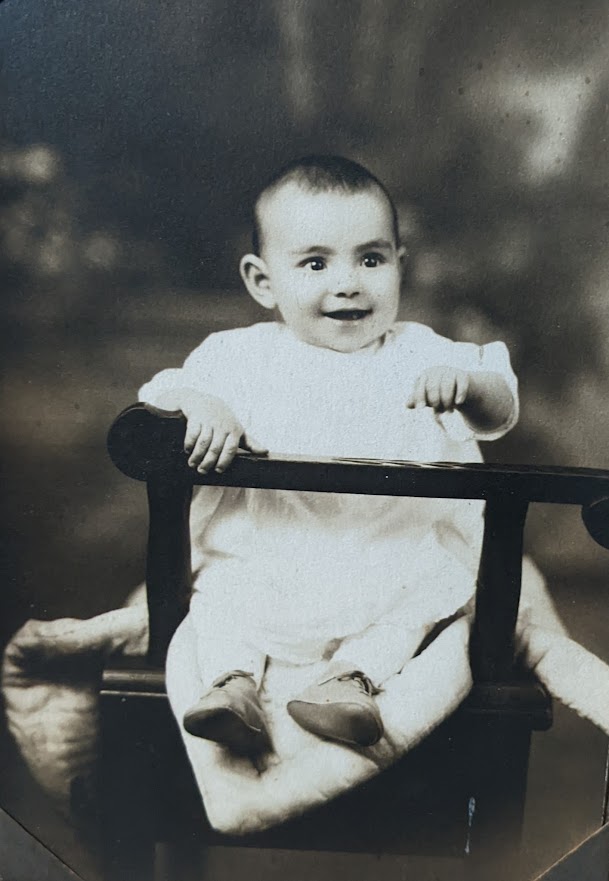
Love Story of a Girl and her Chickens
I was born in 1933 to give a little background, and about the age of 3, I would become infatuated with baby chickens. I lived on a farm where my dad had hogs, cattle, milking cows, and horses, and my mother raised chickens and had a huge garden. We had no electricity, running water, or bathroom; we heated the house with a wood/coal furnace; we carried water to the house from a deep well; we had kerosene lamps, cooked on a cookstove, and had a 2 hole outhouse.
It was hard work and most of the work had to be done by hand. We always had plenty to eat, a warm house, and Model T to take us to church and town to get supplies and repairs. I was an only child, so I had to make up my own fun. At first, I would go everywhere my mother would go. I guess that’s why I learned to work and help with chores around the farm at an early age. No one else to play with.
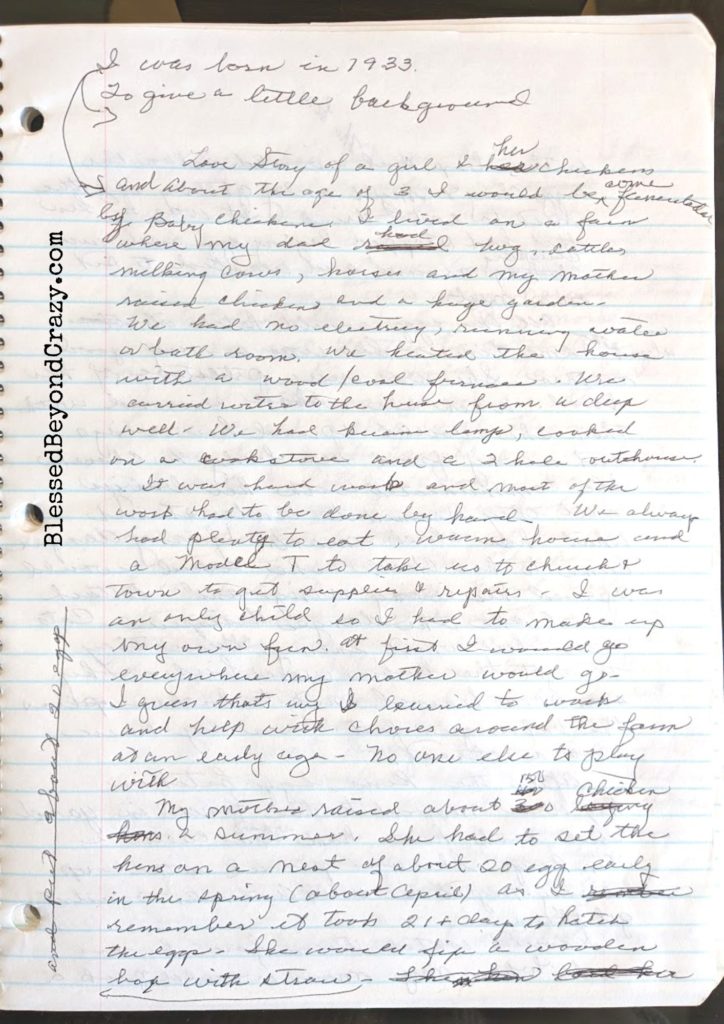
My mother raised about 150 chickens a summer.
She had to set the hens on a nest of about 20 eggs early in the spring (about April). As I remember, it took 21+ days to hatch the eggs. She would fix a wooden box with straw and put about 20 eggs in the box, and the hen would sit on the eggs day and night, only getting off the nest to eat and drink. It was a hen that had stopped laying eggs and was clucking around and wanted to sit on a nest.
All the eggs would hatch at about the same time. She was a very good mother. She was very protective of her brood. When she walked around with them, she would spread her wings out away from her body and cluck. She communicated with her babies, and they seemed to understand what her cluck meant. If any danger came to her chicks she would spread her wings and attack until the danger disappeared. Cats were her worst enemy. Guess they thought the babies were birds. They soon learned not to bother, and the babies grew fast. Farm dogs were also a threat.
After the hen’s eggs hatched they were moved to the fenced-in yard. Each hen had what was called a Tin Coup. She was pinned in the coup every night, so wild animals wouldn’t get them.
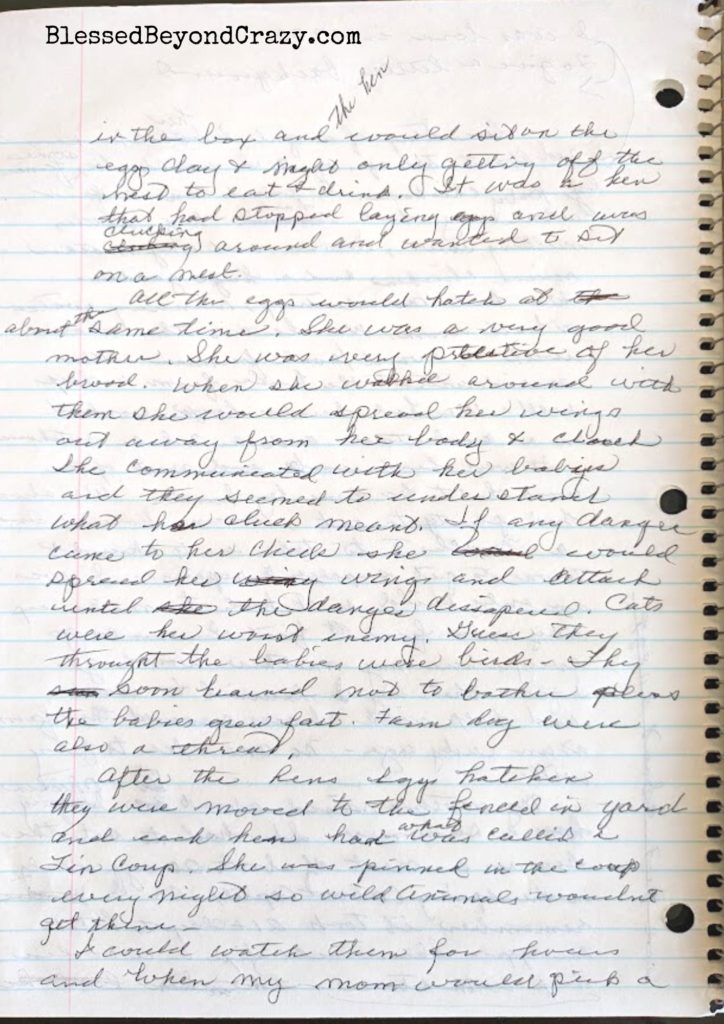
I could watch them for hours.
When my mom would pick a baby up she would let me hold it. It was so soft and cuddly. I would put the baby nest to my cheek and it was so soft. Unfortunately, she wouldn’t let me hold them long because mama hen was very nervous about the whole deal. My mom would warn me not to try to catch one by myself. Did I listen? No! So I would catch one and go sit on the front porch and play with them.
One day I caught one, and it let out a lot of noise. Mama hen got really upset–spread her wings out and started running after me. Instead of letting the chicken go I clutched it in my hand and started running towards the house screaming and the mother hen running after me clucking and her wings spread. Mom came out the door to see what was going on. It must have been a sight. She laughed, and I fell down still holding the chicken in my hand. By that time momma hen was on top of me just pecking away. Mom did intervene and I learned a good lesson.
It didn’t faze me, I still loved chickens.
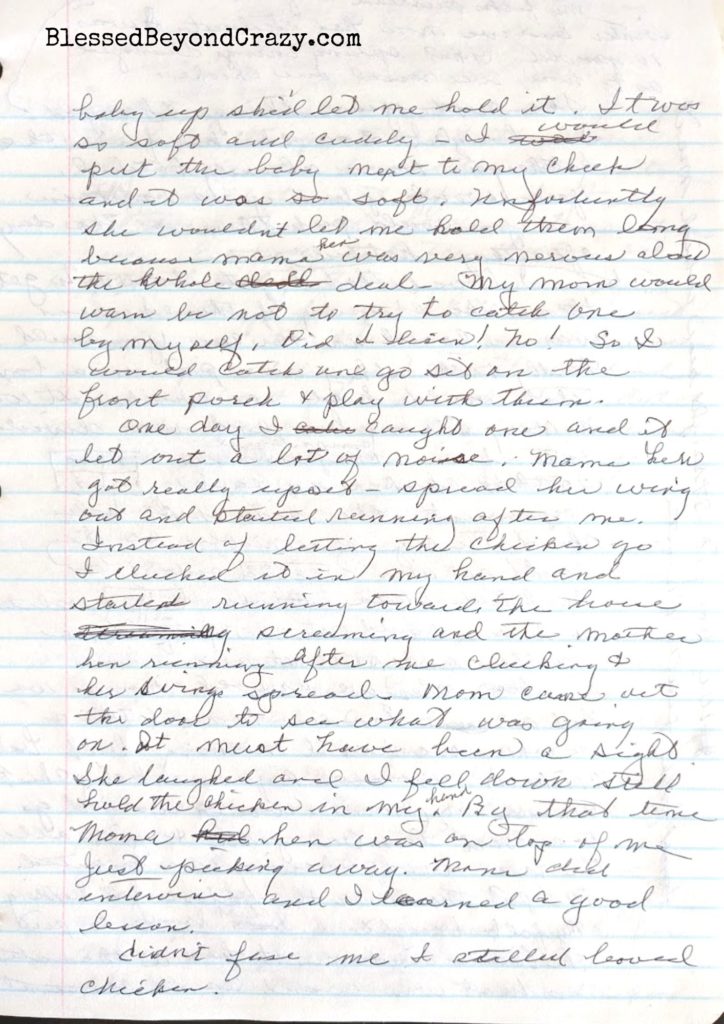
1943
My folks purchased a farm that winter, and we now had electricity. I was 10 years old. that spring things changed as to how we raised our chickens. She bought 300 chicks from the hatchery in town, already hatched. You would place your order in, and you could pick them up on the day after they were hatched. We bought straight run which meant both pullets and roosters.
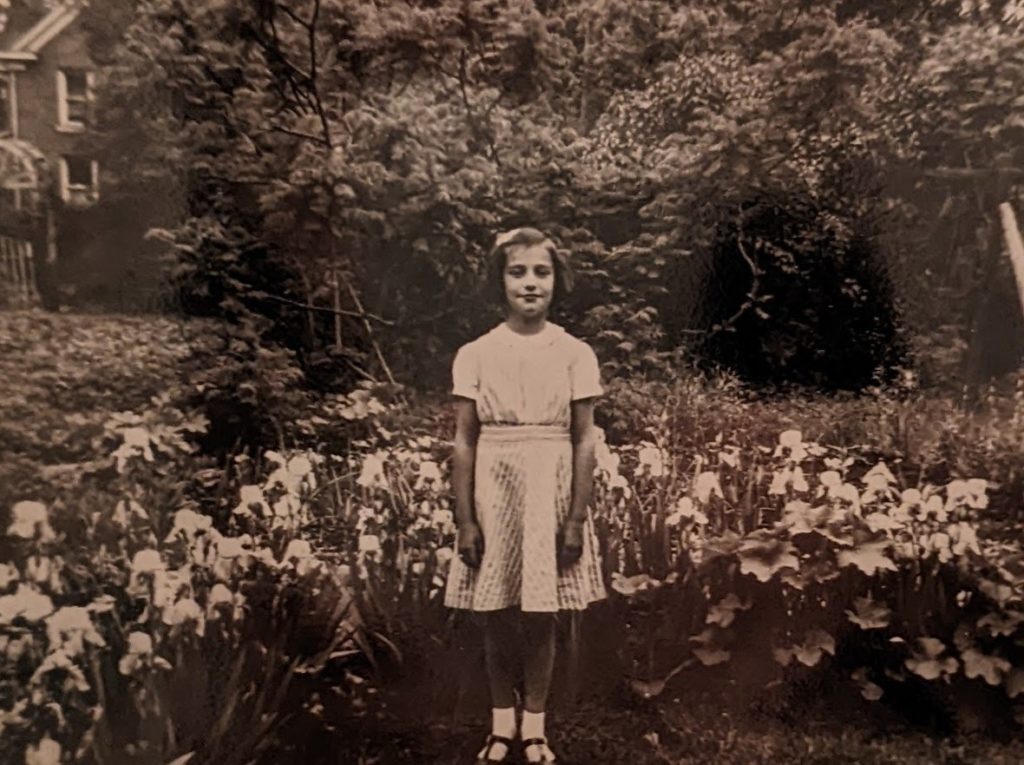
I loved that trip to town to get them.
The cheeping of the chickens was so loud in the car, you could hardly talk. They were put in a box that would hold 100 chicks. it was a very strong box and was divided into four compartments, with 25 chicks in each compartment. The side had holes about the size of a nickel, so they could get air. The lid also had holes, so boxes could sit on top of one another and still get air.
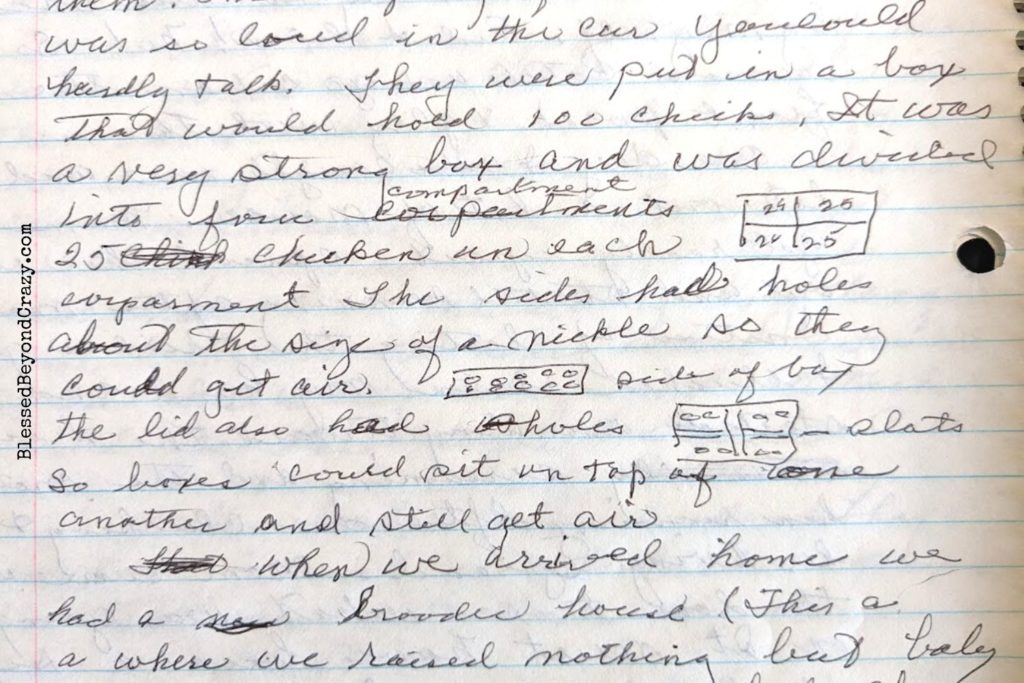
When we arrived home, we had a brooder house. (This is where we raised nothing but baby chickens). Before baby chickens arrived, my mom would go to a local lumberyard and get all the free wood shavings we wanted. We put these on the floor for bedding.
My folks bought a chick brooder to put the babies under. It had a thermometer, so the heat was even. The temperature is dropped 5 degrees each week until chicks no longer need a brooder. By that time they have a full set of feathers. The younger, the higher the temperature, and the older they were, the lower the temperature. They would turn it off in the daytime and on the warmer the outdoor temperature rose. Eventually, we took the heater out of the building. As they grew we put roost up for the chickens to roost and sleep on. The chickens would free-run in a fenced-in pen in the orchard. They could eat grass, and scratch in the dirt.
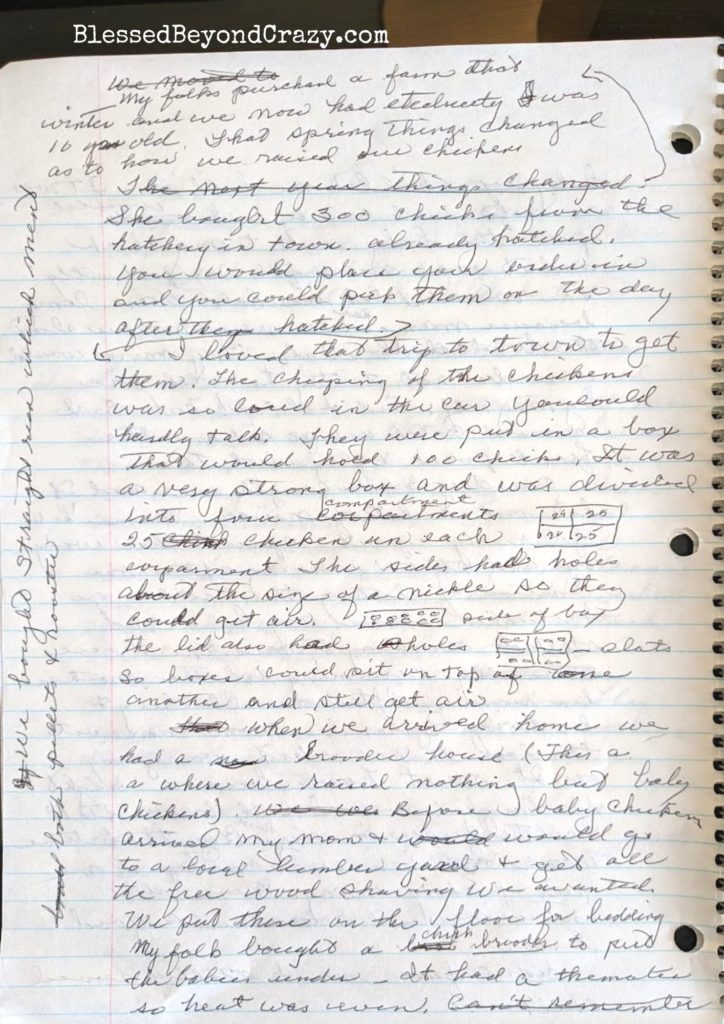
Processing Meat Chickens
As the baby chickens were growing, we would get the hen house ready for the new pullets, which meant selling the old 2-year-old pullets. We had customers from our town who would buy them to make chicken salad, pressed chicken, chicken pot pie, or chicken and noodles. they were too tough to fry. The chicken house was then cleaned and sterilized.
When 2 1/2 to 3 1/2 lbs were reached the young pullets were moved to the hen house along with enough roosters to fertilize the eggs properly. The rest of the roosters were eaten throughout spring and summer. When we got electricity we bought a freezer and put chickens in it for the winter.
I learned how to kill a chicken, scald the chicken, pluck the feathers, and singe the pin feathers off. When a chicken was killed, it would flop around until it bled to death. then we dipped it in a bucket of hot water. Their feathers could then be peeled off. The feathers we dried and stuffed in a pillowcase. This is how feather pillows were made. My grandma made pillows and feather mattresses out of them. After the feathers were pulled out we would singe the chicken by lighting newspaper and holding the chicken over the flame. The pin feathers would get burned off.
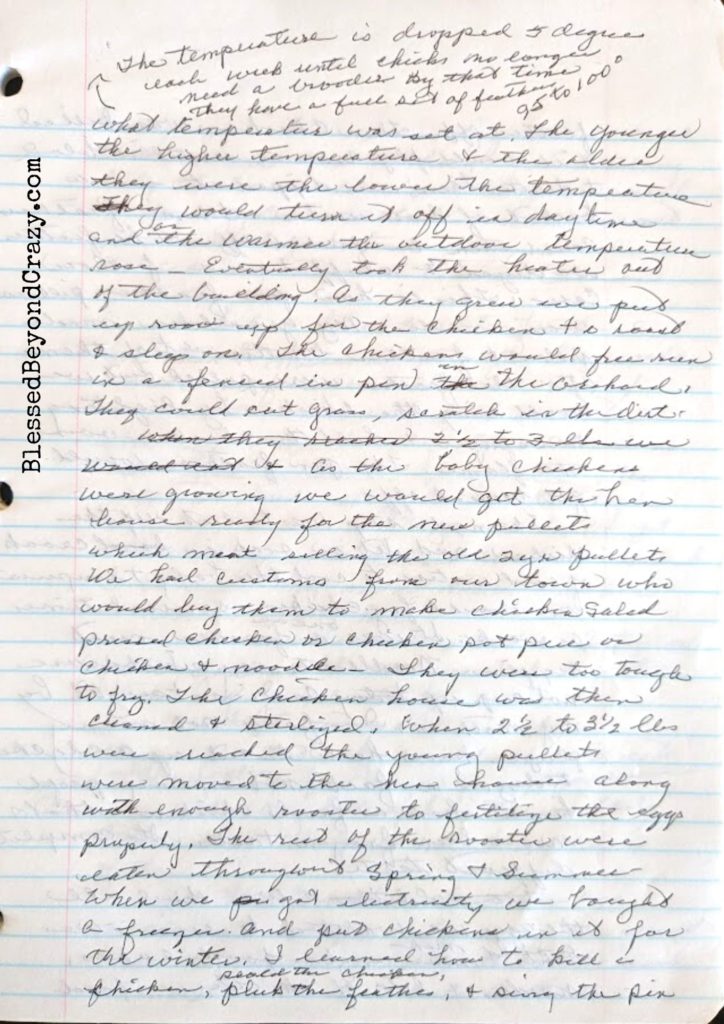
The next step was to cut up the chicken and let it soak in a crock of cold water to cool the body temperature. We would fry chicken several times a week. It was one of a farmer’s meat supplies. Needless to say, chickens are not cut up today as I was taught by my mother. In fact, not many people know how a fresh chicken that has never been frozen tastes. It is a completely different taste.
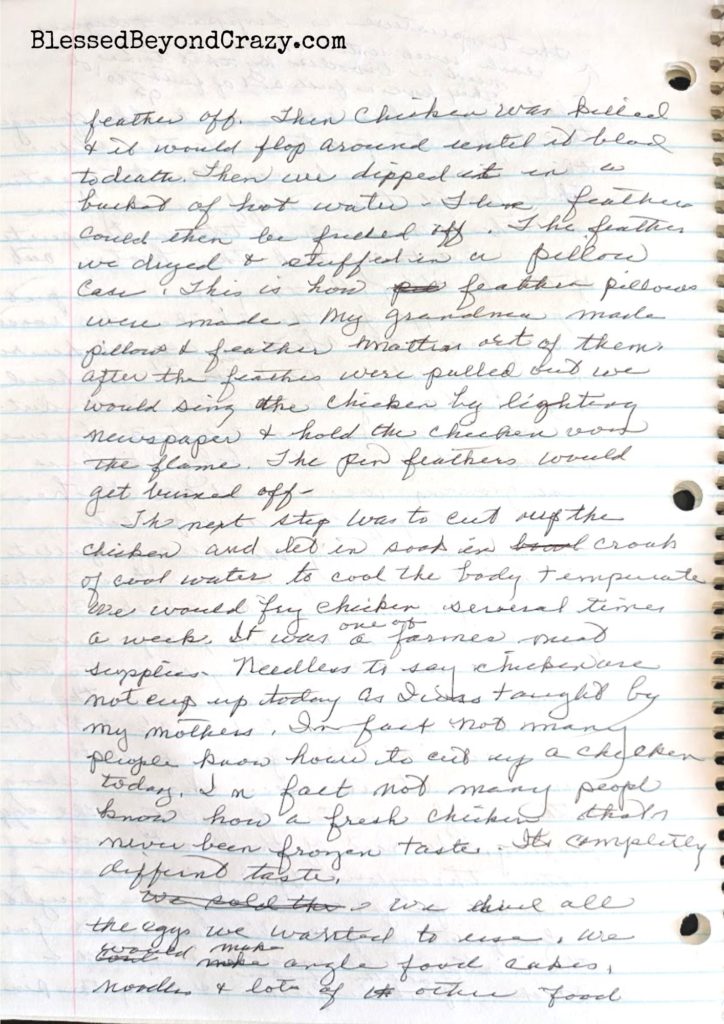
We had all the eggs we wanted to use.
We would make angel food cakes, noodles, and lots of other food using eggs. The excess eggs were sold to the hatchery for hatching baby chickens. We would get several 30 dozen egg cases a week, which meant we would go to town every week to deliver them to the hatchery.
I had a black and white feathered hen that I made a pet of. She would come to the fence and eat corn out of my hand. When my folks started to sell eggs to the hatchery, the chickens all had to be white-feathered. No different breeds were accepted. So the black and white chickens had to go. When I got older, I begin to think about that incident and I suspect my mom made chicken and noodles out of her.
The manure was used as fertilizer for the garden. It was wonderful, better than any you could buy.
I kept raising chickens through the years. But only raised them to eat and only kept a few layers for eggs. When my kids got into their early teens they helped me take care of them.
You had to watch for lice on the chickens as they got older. We would treat the chicken roost with used motor oil. It would kill the lice, and therefore the lice on the chickens.
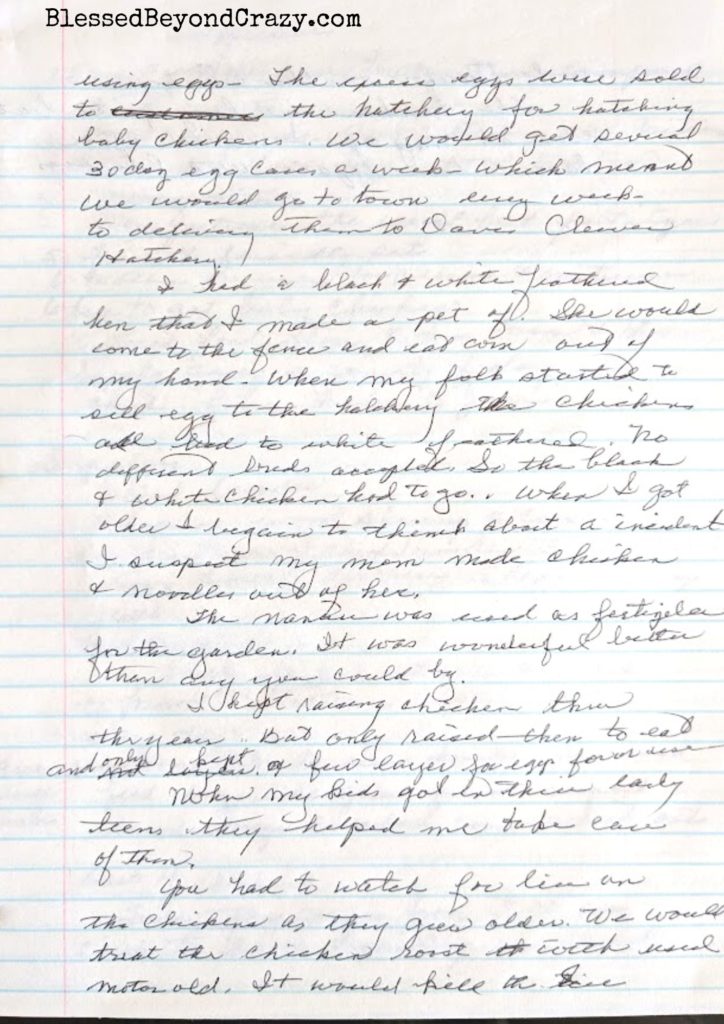
The hen house is long gone, but even at my age, I would still have a love affair with chickens.
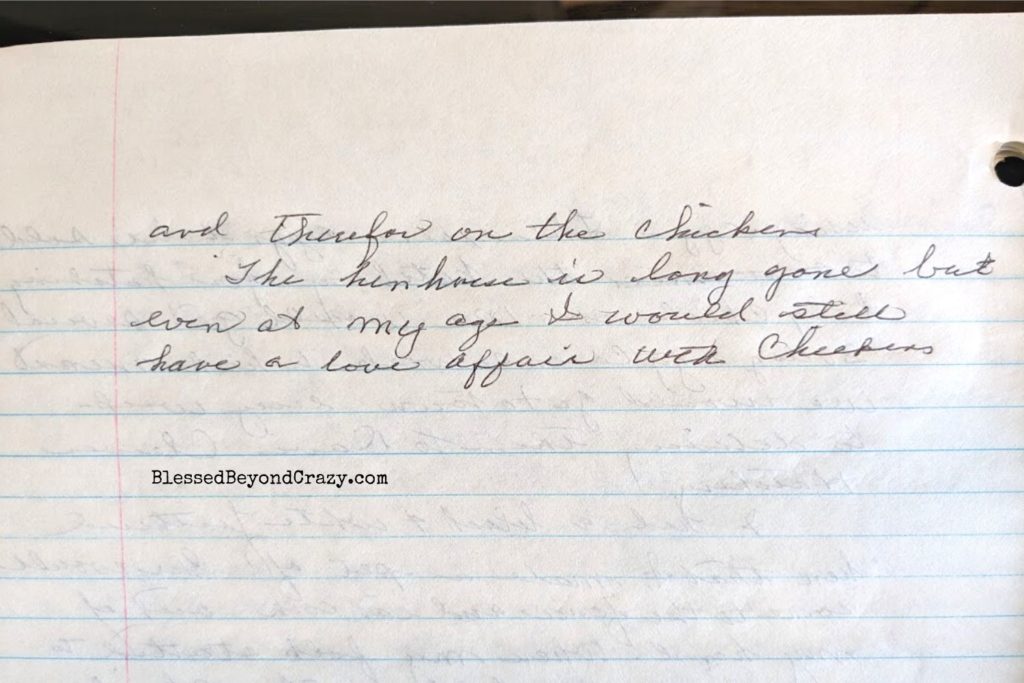
Pros of Chickens
- Easy and inexpensive to maintain compared to most other pets.
- Eggs are fresh, great tasting, and nutritious.
- Chemical-free bug and weed control
- Manufacture the world’s best fertilizer.
- Fun and friendly pets.
- Feathers are used for pillows and mattresses.
Where to get baby chickens: Local Feed stores and Farm and Home Supply carry a variety of day-old chicks from Feb. to June.
Supplies
- Chick brooder
- For flooring– wood shavings, or corn cob
- The temperature of the chick brooder is 90-100° F the first week, decreasing by 5 degrees every week.
- Food and water — chick starter, then switch to formulated feed. Change the water every day.
Free-range chickens like to run. Besides purchased feed, they like green grass, scraps of bread, bugs, cracked corn, and wheat oats.
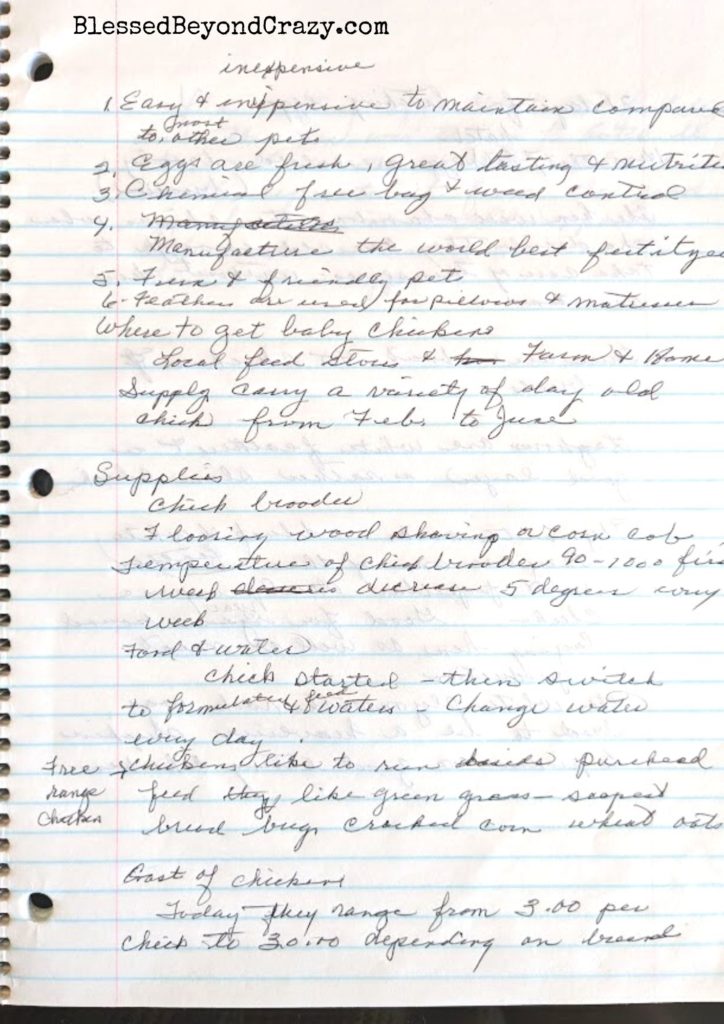
Cost of Chickens
Today, they range from $3.00 per chick to $30.00 depending on the breed.
Hatching Eggs
It takes 21 days for hatching eggs. Hens that hatch eggs are called broody. The hen will abandon the chicks when she decides they are old enough to take care of themselves without her assistance.
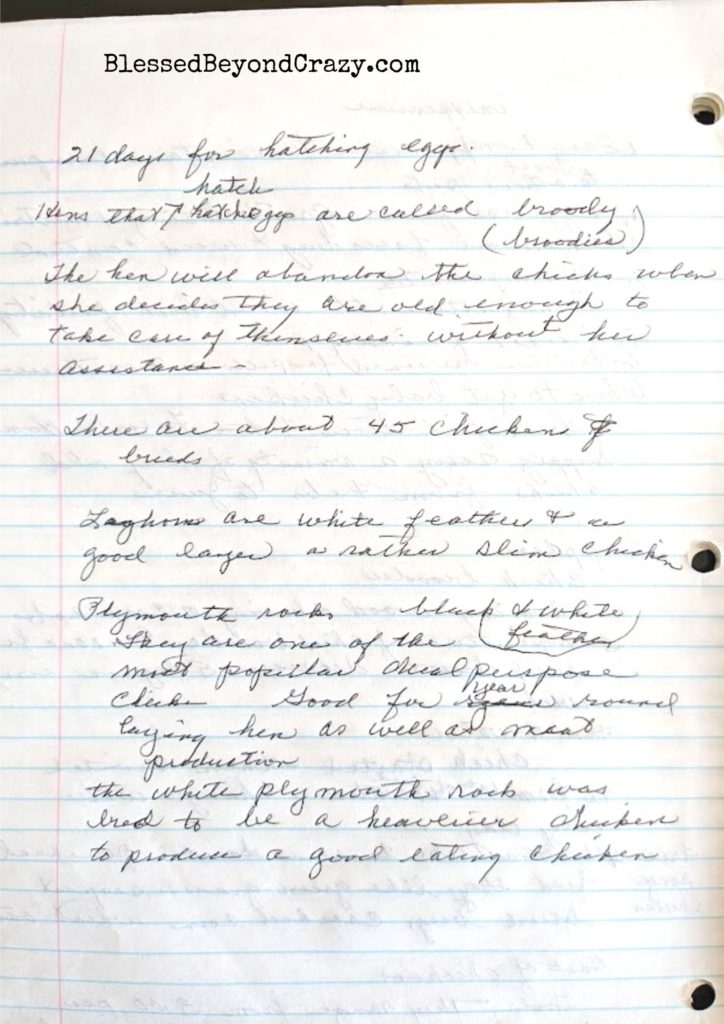
There are about 45 chicken breeds
Leghorns are white feathers and a good layer — a rather slim chicken.
Plymouth rocks are black and white feathers. They are one of the most popular dual-purpose chicks, and they are good for year-round laying hens as well as meat production.
The white Plymouth rock was bred to be a heavier chicken to produce a good-eating chicken.
If a nesting egg didn’t get fertilized and the hen was trying to hatch it, it would eventually rot. The hen would separate it from the good egg because it would explode and make a smelly mess on the hen and other eggs.
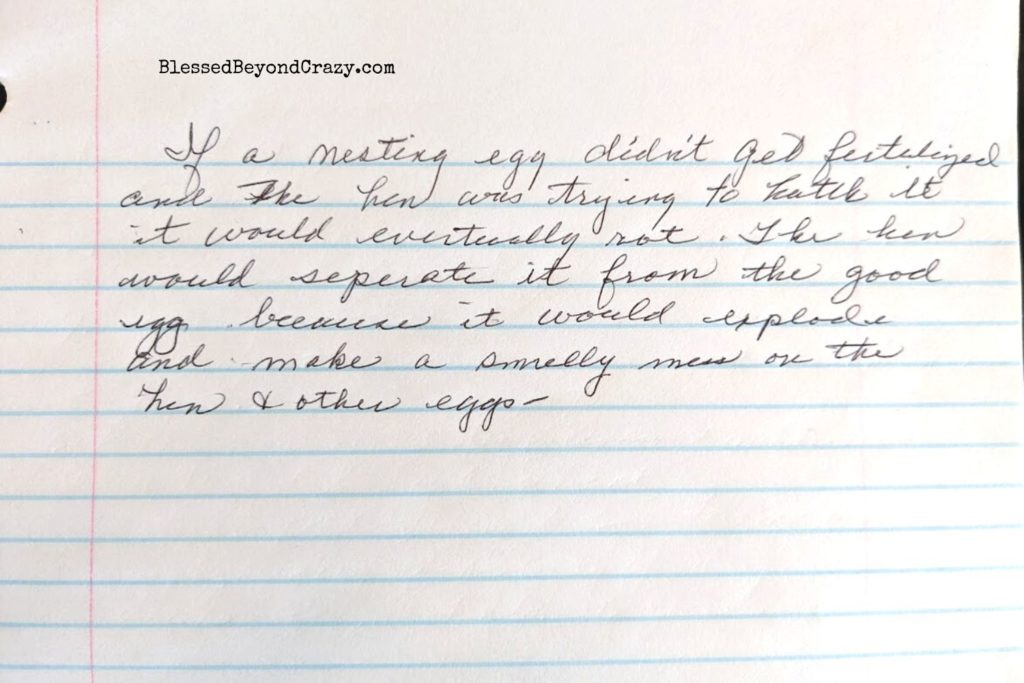
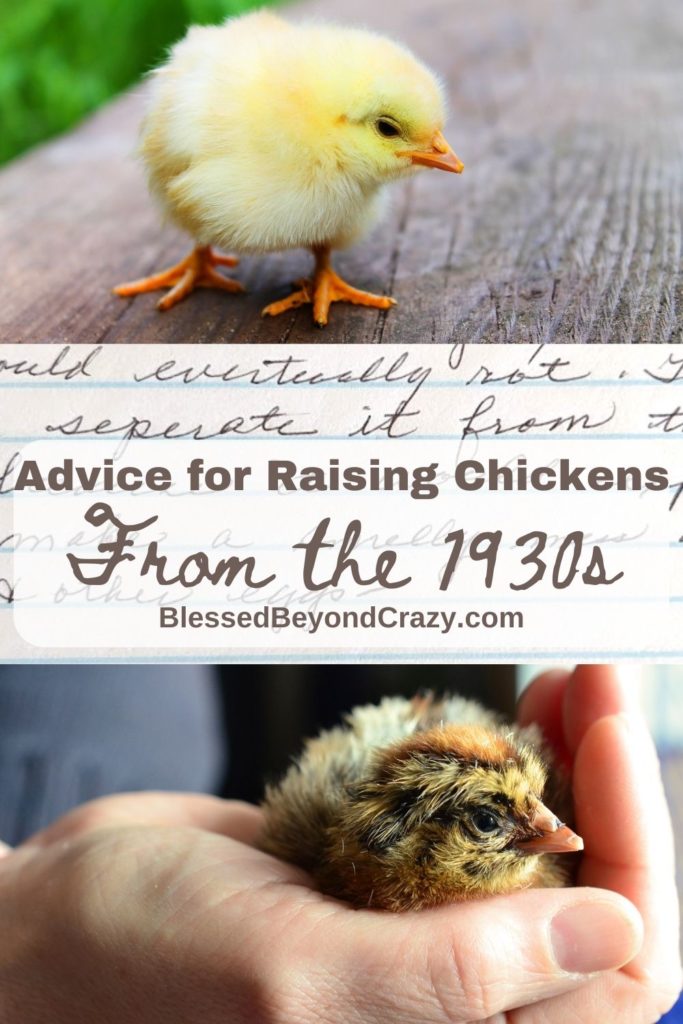
Check out more posts from Blessed Beyond Crazy that feature my Grandma’s farm:
Leave a Reply